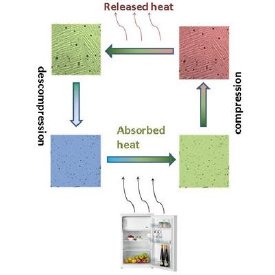Apr 18 2010
Two teams based at the Barcelona Knowledge Campus, one from the University of Barcelona (UB) and one from the Universitat Politècnica de Catalunya (UPC), have worked with a group from the University of Duisburg-Essen (Germany) to develop a new solid material that produces a caloric effect under hydrostatic pressure (solid-state barocaloric effect). The work was carried out using a high-pressure system developed by the UPC, which is the only one of its type in Spain. The research is described in an article published in the scientific journal Nature Materials and was inspired by guidelines in the Kyoto protocol on renewing current refrigeration systems based on the compression of harmful gases.
Research into materials showing large caloric effects close to room temperature is one of the areas currently being explored to develop new refrigeration systems. Until recently, the most promising materials for applications in this field were giant magnetocaloric materials, which change temperature under the influence of an external magnetic field. The authors of this new study show that application of a moderate hydrostatic pressure to a nickel-manganese-indium alloy (Ni-Mn-In) produces results comparable to those achieved with the most effective magnetocaloric materials. According to Lluís Mañosa, a professor with the Department of Structure and Constituents of Matter at the UB and principal investigator of the study, "the aim of this field of research is to identify materials that are efficient, economic and environmentally respectful, and the advantages of the alloy used in this study is that all of the component materials meet these requirements".
 Schematic representation of a refrigerator system based on the compression of a solid material. During decompression, the solid undergoes a phase transition that lowers its temperature. The cold solid absorbs heat, cooling the refrigerator. In the next stage, the solid is compressed, returning it to its original phase and increasing its temperature. Finally, the solid releases the excess heat into the atmosphere.
Schematic representation of a refrigerator system based on the compression of a solid material. During decompression, the solid undergoes a phase transition that lowers its temperature. The cold solid absorbs heat, cooling the refrigerator. In the next stage, the solid is compressed, returning it to its original phase and increasing its temperature. Finally, the solid releases the excess heat into the atmosphere.
In addition, Antoni Planes, a professor with the same UN department, explains that, "this type of material can produce much greater caloric effects with only slight variations in pressure, which makes it ideal for domestic refrigeration systems (refrigerators, air conditioning, etc.)". When these alloys are submitted to an external field, either magnetic or pressure, the material undergoes a solid-state phase transition, and Lluís Mañosa explains that, "this phase change generates a considerable latent heat exchange". The physical principle involved is the same as the effect observed when an ice cube is placed into a glass of water: the ice absorbs heat from the water, lowering its temperature.
The experiments were carried out using a unique high-pressure system developed by the Materials Characterization Group at UPC, directed by Josep Lluís Tamarit, a professor with the Department of Nuclear Physics and Engineering. The system was designed to measure the temperatures during state changes according to the pressure and heat exchanged in the process.
According to the researcher Maria Barrio, who works for the same UPC department and co-authored the study, "studying the behaviour of materials under different pressures has a wide range of uses in many fields", and applications include various types of refrigeration systems, such as domestic refrigerators and air-conditioning systems, food storage facilities, industrial machinery and supercomputers. Scientists have understood the magnetocaloric effect for some time, and it has been used extensively in work requiring extremely low temperature, but it was not until the 1990s that experts discovered materials capable of producing a large magnetocaloric effect close to room temperature, or giant magnetocaloric effect.
In 2005, an article in Nature Materials presented the inverse magnetocaloric effect, under which the temperature of a material submitted to an external magnetic field decreases instead of increasing, which is the standard response of most magnetic materials. The study, carried out as preparation for the doctoral thesis of Xavier Moya, under the direction of Lluís Mañosa (UB), was awarded the 2009 Ramon Margalef Prize by the UB Board of Trustees. In addition to the barocaloric effect described above, the Ni-Mn-In alloy also exhibits the inverse magnetocaloric effect. As such, the magnetic field can be combined with exertion of hydrostatic pressure to produce the caloric effect, which can be modulated with a series of parameters to control the temperature. With this new material it is possible to observe the pressure and the magnetic field to control the state change at a desired temperature.